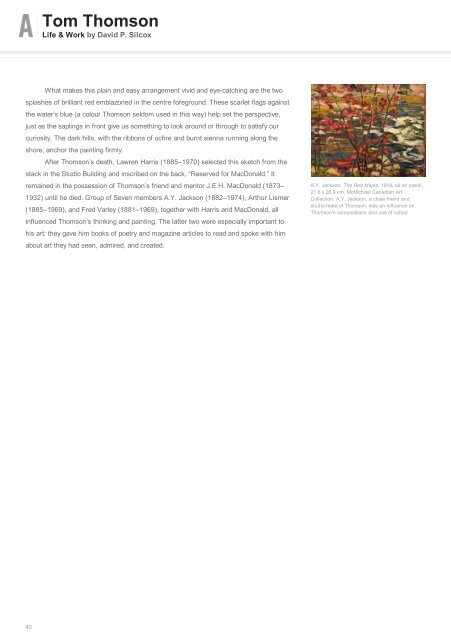Create successful ePaper yourself
Turn your PDF publications into a flip-book with our unique Google optimized e-Paper software.
<strong>Tom</strong> <strong>Thomson</strong><br />
Life & Work by David P. Silcox<br />
What makes this plain and easy arrangement vivid and eye-catching are the two<br />
splashes of brilliant red emblazoned in the centre foreground. These scarlet flags against<br />
the water’s blue (a colour <strong>Thomson</strong> seldom used in this way) help set the perspective,<br />
just as the saplings in front give us something to look around or through to satisfy our<br />
curiosity. The dark hills, with the ribbons of ochre and burnt sienna running along the<br />
shore, anchor the painting firmly.<br />
After <strong>Thomson</strong>’s death, Lawren Harris (1885–1970) selected this sketch from the<br />
stack in the Studio Building and inscribed on the back, “Reserved for MacDonald.” It<br />
remained in the possession of <strong>Thomson</strong>’s friend and mentor J.E.H. MacDonald (1873–<br />
1932) until he died. Group of Seven members A.Y. Jackson (1882–1974), Arthur Lismer<br />
(1885–1969), and Fred Varley (1881–1969), together with Harris and MacDonald, all<br />
influenced <strong>Thomson</strong>’s thinking and painting. The latter two were especially important to<br />
his art: they gave him books of poetry and magazine articles to read and spoke with him<br />
about art they had seen, admired, and created.<br />
First Snow in Autumn 1916<br />
A.Y. Jackson, The Red Maple, 1914, oil on panel,<br />
21.6 x 26.9 cm, McMichael Canadian Art<br />
Collection. A.Y. Jackson, a close friend and<br />
studio-mate of <strong>Thomson</strong>, was an influence on<br />
<strong>Thomson</strong>’s compositions and use of colour<br />
40


